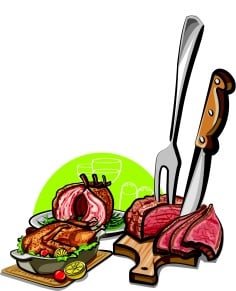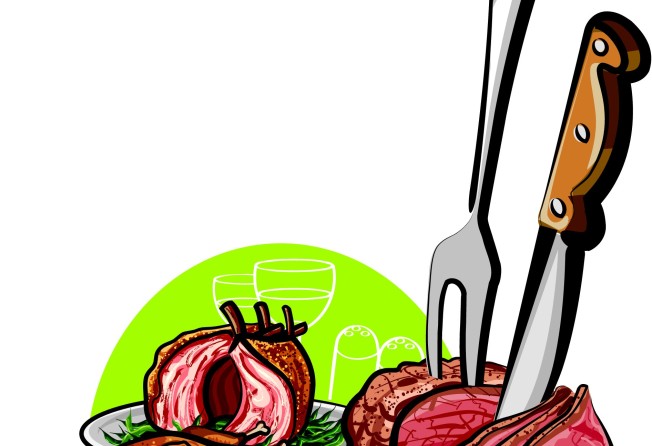
Truc: Ahead of the carve
Susan Jung

When it comes to cooking a holiday feast for a crowd of people, many hosts plump for turkey, beef, pork or any cut of meat big enough to feed everyone, then serve it with a good number of side dishes. But making a roast doesn't end with pulling the meat out of the oven and using the drippings to make gravy. You need to carve it - and that takes skill and a very sharp knife.

The ideal vision of the host or hostess masterfully wielding a large knife to cut off slices of moist, perfectly done meat before a table of delighted guests, is much more difficult to achieve than it looks - I've seen many a beautiful roast butchered by inept carvers.
You don't need a carving set - a large two-pronged fork and a sharp knife with matching handles - but it is convenient and looks nicer than a fork and chef's knife (which, I'll admit, I've used before). The carving fork's long prongs are good for holding meat steady and it's also sturdy enough to use to lift the roast onto the cutting board or to turn it over.
The carving knife has a long (but not too long), straight blade that easily slices off thin pieces of meat. Please don't use an electric knife - it is inelegant and unwieldy. You also need a cutting board that's large enough to hold the roast securely. Those with grooves on the edges are useful as they stop the meat drippings from overflowing.
The easiest things to carve, of course, are boneless chunks of meat. For these, the only thing to remember is that you need to slice the meat against the grain. Bone-in roasts - such as lamb or pork rack, or a rib roast - are also easy, as long as they've been chined (had the backbone that runs perpendicular to the ribs removed - a difficult operation best left to the butcher).
Once the meat has been cooked, all the carver needs to do is slice between the ribs, if it's a small enough roast (such as pork or lamb), and serve the pieces. You can't really do this with a rib roast, though, because the bone-in slices would be far too thick. Instead, remove the entire chunk of meat in one piece by cutting it off parallel to the bones, then put the meat on the cutting board and slice it against the grain. The bone portion can be cut into individual ribs.
Turkey and other types of whole poultry are the most challenging. They all have a similar bone structure, though, so once you learn to carve one bird, you know - with some variations - how to carve the others (although geese and ducks have less meat and tougher sinews). It's a good idea to practice on roasted chickens before undertaking the task of carving turkey in front of guests. Put the bird breast-side up on the cutting board; plunge the fork into the breast, to anchor it; then use the knife to slice between the legs and the body. Detach the legs by cutting them off at the joint where they meet the carcass. Separate the thigh and the drumstick between the joint, then slice off the meat by cutting parallel to the bones.
There are two main ways to carve the breasts. In one, the breast remains attached to the carcass as the meat is cut it off in slices, although this is slightly unfair, because whoever gets the first slice gets all the crisp skin. It's also not as neat because the slices are uneven as you get closer to the bone.
With the second method, the entire breasts are detached intact. Cut parallel to the breast bone, then continue to slice as closely as possible along the ribs; the breasts will come off in two neat pieces. Put them on the board and cut them into even slices, each with a bit of skin. Lay the pieces on the serving platter, then turn the carcass over to remove the wings, which can be separated into two pieces: a drumette and a middle joint with wing tip. Remove the tail and the "oysters" (two succulent nuggets of meat in the backbone) which are the best part of the bird. After you're done, use the carcass to make stock.
Truc (tryk): noun, masculine, trick, gimmick, device. A French word for a chef's secret.